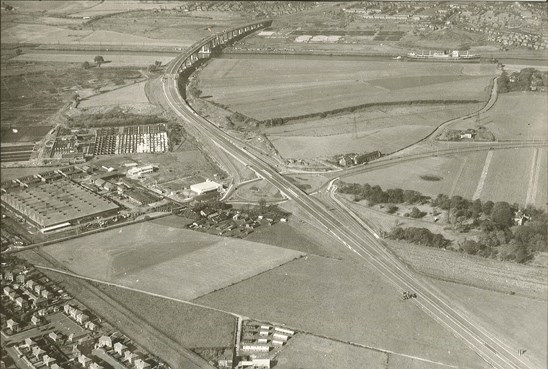Did you know the TraffordCity area has a rich and interesting history dating back to the 18th century? It's a fascinating tale of canal construction, innovative engineering and industrial development.
Brindley's aqueduct opens in 1761

Opened on 17 July 1761, Brindley’s aqueduct was a three arched stone bridge, 200 yards long and 12 yards wide, which carried the Bridgewater canal over the River Irwell.
The stone aqueduct stood until the early 1890’s when it was removed during the construction of the Manchester Ship Canal; the masonry arches were too small for the passage of large ocean-going ships and it was replaced by the current swing bridge.
Remnants of Brindley's aqueduct can still be seen today

To this day, remnants of Brindley’s original stone aqueduct (1761-1893) complete with stone mason’s marks can still be viewed in Pocket Park. It is believed that these marks were used to indicate which mason had actually carried out which piece of work - and allowed them to be paid accordingly.
Sir Humphrey de Trafford and the Trafford Park estate

Ever wondered where Trafford got its name? Sir Humphrey de Trafford (1808-1886) was the owner of the Trafford Park estate and an opponent of the Manchester Ship Canal, objecting that it would bring polluted water close to his residence, interfere with his drainage, and render Trafford Hall uninhabitable. Despite his objections the bill was passed in 1885.
Marshall Stevens (1852-1936)

Marshall Stevens (1852-1936) is buried in St Catherine’s churchyard, Barton. His work with Daniel Adamson led to the construction of the Manchester Ship Canal, which was completed in 1894. He later became the general manager of the company (1891); leaving the company in 1897 to become the general manager of Trafford Park Estates.
Bridgewater Canal bridge agreement in 1891

An agreement was drawn up between the Manchester Ship Canal and the Barton Eccles Winton and Monton Local Board for the construction of a bridge to carry the Bridgewater Canal over Barton Lane. This was at a clear width of 30 feet with the requirement of lowering the existing road in order to carry out these works, 20 June 1891.
The Barton Swing Aqueduct opens in 1894

The Barton Swing Aqueduct is a moveable navigable aqueduct which carries the Bridgewater Canal across the Manchester Ship Canal. The swinging action allows large vessels using the ship canal to pass through and smaller craft, both narrowboats and broad-beam barges to cross over the top. If you look closely at the picture above you can see the horses that pulled the barges on the canal.
The aqueduct, the first and only swing aqueduct in the world was officially opened in 1894 and is a Grade II listed building, considered a major feat of Victorian civil engineering. The below photograph depicts the construction of the Barton Swing Aqueduct in 1893.

Cottages built for the 'men on the bridge' in 1922

The cottages on Chapel place in Barton (as seen on the right of this picture) were constructed just after 1922 and were built by the Manchester Ship Canal Company for the use of ‘the men on the bridge’
Parcels of land purchased in 1922

Plan depicting the parcels of land owned by the De Trafford Family, which were purchased by the Manchester Ship Canal Company and the acreage of each one. The plan originally dated from 1922 but includes several addenda.
Barton Power Station opens in 1923

Photograph taken by Imperial Aerial Photo in 1925 depicting the Barton Power station which opened in 1923.
It was a coal-fired power station; coal was delivered in barges using the Bridgewater canal and the steam was condensed and cooled using water abstracted from the canal. In a report to the Manchester Ship Canal Company in 1918 (power station planning stage) it was estimated that the Barton Electricity Power station would need to use 56,000,000 gallons of water per day.
Sadly, the power station was demolished between 1978 and 1979.
Dumplington Estates acquired in 1929

In 1929, the Manchester Ship Canal Company acquired Dumplington Estates. Dumplington was one of several hamlets in the township of Barton-upon-Irwell. Its name derives from the old English dympeland in and tun which means and enclosure by a pool.
Barton Dock Estate 1933

The Manchester Ship Canal Company recognised the potential for a new dock on the Dumplington Estates, giving the area its name the Barton Dock Estate (though no dock was ever constructed), 1933.
Ford Shadow factory builds engines for Spitfire and Lancaster bombers

The Ford Shadow factory opened in 1941 on the current EventCity site. During World War II, the factory helped with the war effort by building engines for Spitfire and Lancaster bomber planes.
Barton High level road bridge in 1960

Black and white photograph depicting Barton High Level Bridge and the site of Trafford City pre-development in 1960.
Railway extension construction in 1969

Black and white photograph depicting the construction of a railway extension from the Barton Dock estate to OCL (overseas containers) Ltd, 23 August 1968.
VENUS building opens in 2003

